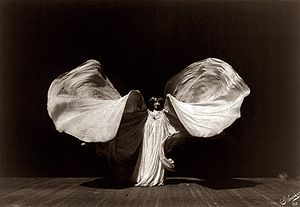Serpentine dance
The serpentine dance is a form of dance that was popular throughout the United States and Europe in the 1890s, becoming a staple of stage shows and early film.
Background
The Serpentine is an evolution of the skirt dance, a form of burlesque dance that had recently arrived in the United States from England. Skirt dancing was itself a reaction against "academic" forms of ballet, incorporating tamed-down versions of folk and popular dances like the can-can.[1]
Development
The new dance was originated by
By 1891, Fuller combined her choreography with silk costumes illuminated by multi-coloured lighting of her own design, and created the Serpentine Dance.[3] After much difficulty finding someone willing to produce her work when she was primarily known as an actress, she was finally hired to perform her piece between acts of a comedy entitled Uncle Celestine, and received rave reviews.[4]
"Soon, she (

Almost immediately, she was replaced by imitators (originally Minnie "Renwood" Bemis). In the hope of receiving serious artistic recognition that she was not getting in America, Fuller left for Europe in June 1892.
Filmed versions
The Serpentine Dance was a frequent subject of early
-
Annabelle Serpentine Dance, No. 2
-
A segment from Annabelle Butterfly & Serpentine Dances
-
Lina Ebrard's Serpentine dance
-
Seven serpentine dances 1897-1907
-
Méliès - La Colonne de feu (The column of fire)
-
Lumière brother's serpentine dance
-
Création de la Serpentine (creation of the serpentine)
-
Colorized excerpt of Création de la Serpentine (creation of the serpentine)
-
Loïe Fuller's Danse serpentine (serpentine dance)
-
Colorized excerpt of Loïe Fuller's Danse serpentine (serpentine dance)
See also
- Serpentinen Tanz
References
- ^ ISBN 978-0-8195-6843-4.
- ISBN 978-1-85273-054-3.
- ^ "Loie Fuller | American dancer". Encyclopædia Britannica. Archived from the original on August 3, 2020. Retrieved October 4, 2017.
- ISBN 9780195173697.
- ^ https://www.timelapsedance.com/loie-fuller-essay
- ^ Bradley Novicoff (September 24, 2009). "The Lumiere Brothers' Danse Serpentine". Dangerous Minds. (See also Martinez Historical Society Facebook page).
